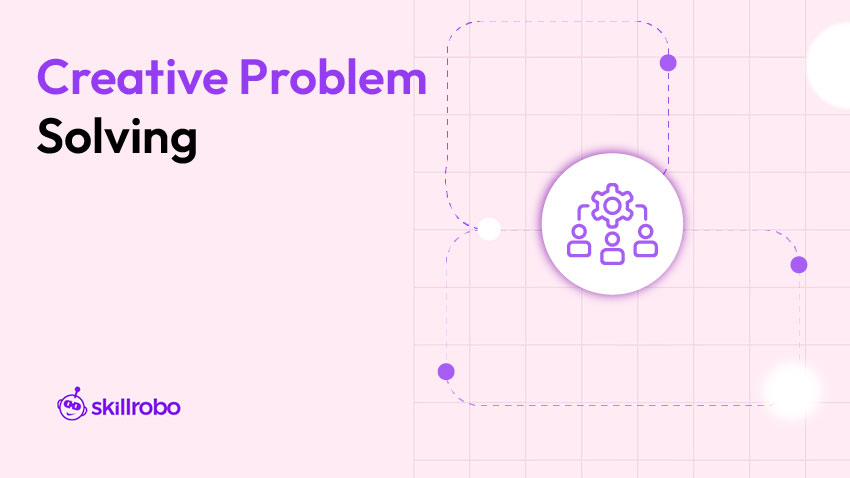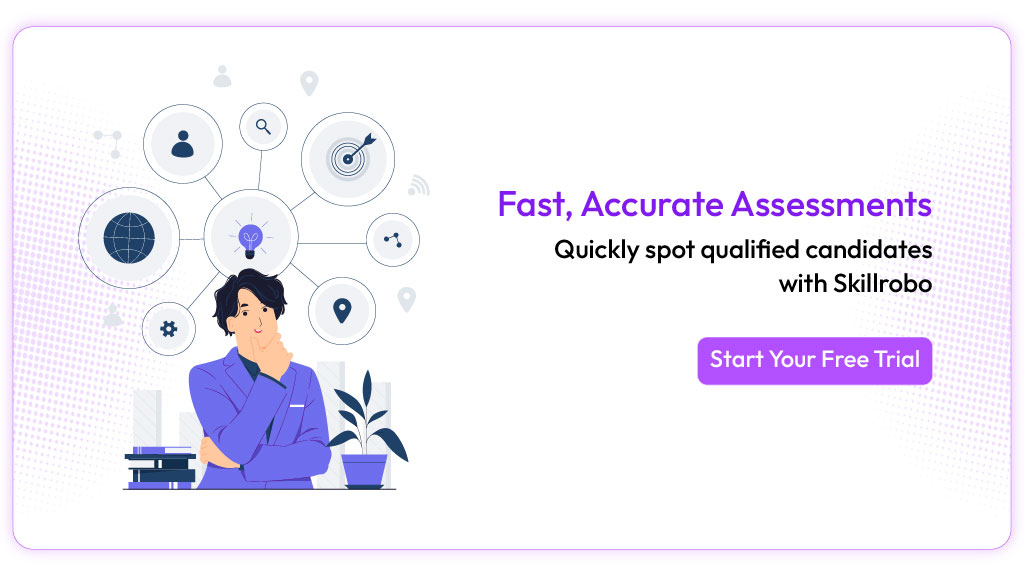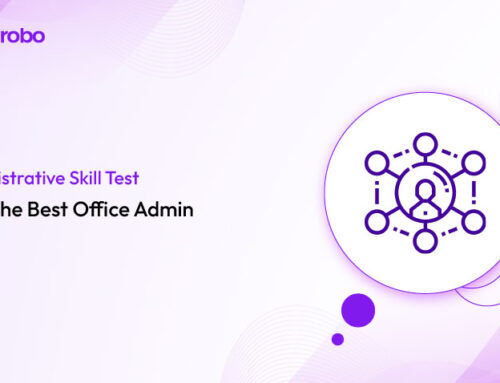
Key Takeaways
- Creative roles require structured thinking, and innovation aptitude tests help assess both. They reveal how candidates approach challenges and solve problems in real-world scenarios.
- Generic assessments often fall short in creative hiring. Role-specific scenarios provide deeper insights and improve the quality of hires.
- Online platforms enable scalable, bias-free, and fast evaluation. They streamline testing while offering data-driven reports for better decision-making.
- Skillrobo offers customizable tests for innovation-driven roles.
Its AI tools and templates help tailor assessments to your team’s unique needs.
Why Problem-Solving Can’t Be Gauged by Resumes Alone
Resumes highlight experience, not potential. In creative and strategic roles, the real question is: Can this candidate think on their feet? Whether it’s a product designer iterating features or a marketing strategist crafting campaign pivots, businesses need people who solve challenges with logic and imagination. That’s where online aptitude tests come in—designed to measure mental agility, situational reasoning, and innovation under pressure.
What Do Creative Problem-Solving Tests Evaluate?
Creative aptitude tests are designed to go far beyond academic intelligence or textbook knowledge. Instead, they simulate ambiguity, complexity, and time sensitivity, just like the real workplace. These tests aim to uncover a candidate’s real-time problem-solving behavior, helping employers identify who can think clearly when it counts.
Here’s what they typically measure:
1. Lateral Thinking
This measures a candidate’s ability to find non-obvious, innovative solutions to complex problems. It’s about breaking away from linear reasoning and exploring multiple perspectives. For instance, in product design or creative strategy, candidates might need to reframe the question itself before finding a useful answer. Many organizations combine lateral thinking questions with situational judgment tests to assess how flexibly candidates apply creative logic in unpredictable environments.
2. Pattern Recognition
Creative problem-solvers can detect patterns where others see randomness. Whether it’s identifying customer behavior trends or spotting inefficiencies in a process, recognizing connections in abstract or incomplete data is a key predictor of success. This form of reasoning is often embedded in inductive reasoning tests, which challenge candidates to spot visual patterns or progressions and apply them quickly.
3. Scenario Logic
Creative problem-solvers can detect patterns where others see randomness. Whether it’s identifying customer behavior trends or spotting inefficiencies in a process, recognizing connections in abstract or incomplete data is a key predictor of success. This form of reasoning is often embedded in inductive reasoning tests, which challenge candidates to spot visual patterns or progressions and apply them quickly.
4. Decision Speed
Time-bound creative challenges test not just what decision a candidate makes, but how quickly and confidently they arrive at it. In fast-paced roles like operations or campaign strategy, speed is as important as accuracy. Timed aptitude tests evaluate how well a candidate performs under realistic pressure, revealing whether they panic, overanalyze, or act with focused confidence.
Rather than asking “What do you know?” these tests ask, “What will you do when things go off script?”
Where Problem-Solving Skills Matter Most
These industries and functions benefit most from creative aptitude testing:
| Role | Why It Matters |
|---|---|
| UX/UI Design | Balancing user behavior with interface constraints requires fast experimentation and feedback response. |
| Product Management | Requires prioritization, strategic trade-offs, and quick pivots based on feedback or market shifts. |
| Advertising & Campaign Strategy | Involves tailoring ideas to shifting audiences, competitors, and channels, often on tight budgets. |
| Customer Experience Design | Must identify root pain points and design sustainable, human-centric solutions. |
| Innovation & R&D Teams | Tasked with solving problems no one has tackled before, logic meets creativity. |
From Brain Teasers to Real-World Simulations
Traditional aptitude tests often relied on abstract puzzles or brain teasers that didn’t reflect the challenges candidates would face on the job. Fortunately, today’s top platforms have evolved far beyond this. Modern problem-solving tests now prioritize realism and role relevance, using formats designed to mimic workplace dynamics, particularly for innovation-focused and decision-heavy roles. Here’s what that looks like:
- Role-specific simulations – Candidates are presented with tasks based on common job scenarios, such as allocating project resources, troubleshooting client issues, or streamlining a workflow under constraints.
- Visual sequencing and diagrammatic reasoning – Especially useful for tech, UX, and product roles, these tests gauge how well someone can organize abstract information and recognize logical sequences in visual form.
- Scenario-based decision trees – Candidates are given layered choices, each with consequences. This helps assess how they evaluate risks, manage ambiguity, and prioritize competing goals.
- Timed interactive tasks – By introducing deadlines, platforms simulate real-world pressure, revealing how candidates handle time-sensitive problem-solving without sacrificing accuracy.
Pro Tip: Match the complexity of the test to the seniority of the role. Junior roles may focus on structured logic, while leadership positions can use layered, open-ended simulations. For examples of how situational tests predict real job performance, check out this guide on situational judgment assessments.
| Test Type | Focus |
|---|---|
| Logical Reasoning | Evaluates deductive and inductive thinking through sequences, assumptions, and rules. Ideal for structured decision-making roles. |
| Abstract Reasoning | Tests the ability to identify visual patterns or logical links, common in design, innovation, and development roles. |
| Scenario-Based Judgement | Measures prioritization and ethical decision-making in job-specific dilemmas. Often used in leadership hiring. |
| Caselet Simulations | Presents a condensed business scenario with missing data. Candidates must respond quickly with reasoned actions. |
Want to strengthen your decision-making evaluation? Combine scenario-based tests with behavioral assessments to gain insights into both how candidates think and how they act.
How Online Platforms Enhance the Assessment Experience
Online aptitude platforms offer not just convenience, but a better experience for both recruiters and candidates. Here’s why they’re especially useful for creative problem-solving roles:
1. Remote-friendly
With teams increasingly distributed, online testing allows you to assess talent globally without logistical headaches. Candidates can complete tasks from anywhere, while you maintain control.
2. Secure Testing
With browser-lock tools, webcam monitoring, and activity tracking, platforms like Skillrobo ensure test integrity, making it easier to trust the results. Explore more about maintaining assessment integrity in this detailed article on online proctored exam benefits.
3. Customizable Formats
Need a 15-minute logic challenge for analysts or a 45-minute simulation for product managers? Online platforms let you adjust duration, content type, and difficulty—no coding required.
4. Automated Analytics
Once a test is completed, results are categorized, ranked, and visualized, enabling faster shortlisting and reducing manual scoring bias. This supports better decisions with less effort.
Platforms like Skillrobo allow companies to create role-specific tests with drag-and-drop ease, ideal for innovation-focused teams.
Avoid These Common Mistakes
Even with great tools, it’s possible to miss the mark. Avoid these common missteps when using aptitude tests for problem-solving roles:
1. Using One Generic Test Across All Roles – What works for a finance analyst won’t suit a content strategist. Always customize assessments to reflect each role’s challenges and thinking style.
2. Overusing Academic or Puzzle-Heavy Formats – Don’t default to riddles or math-heavy logic questions—unless they reflect real job requirements. Overemphasis on IQ can alienate creative thinkers.
3. Ignoring Soft Factors Like Adaptability and Collaboration – Combine problem-solving tests with soft skill evaluations. Use tools like communication skills assessment tools to identify how well candidates can share, persuade, and adapt ideas.
4. Failing to Simulate Real Decisions – If a candidate won’t encounter abstract puzzles on the job, don’t make them the centerpiece of your evaluation. Simulate dilemmas that mirror your business environment.
Effective creative hiring isn’t about who solves the problem first—it’s about who solves it thoughtfully, in alignment with the role’s actual challenges.
Final Thoughts: Skill Assessments Built for Innovators
Hiring for problem-solving roles isn’t about ticking boxes—it’s about testing for minds that build, adapt, and transform. Skillrobo gives recruiters the power to assess creative aptitude through custom test creation, real-time reporting, and scenario-based scoring. Whether you’re building a design team or scaling product innovation, Skillrobo helps identify the thinkers who move ideas forward. Sign up to start building your creative aptitude test in minutes.
Table of content
- Key Takeaways
- Why Problem-Solving Can’t Be Gauged by Resumes Alone
- What Do Creative Problem-Solving Tests Evaluate?
- Where Problem-Solving Skills Matter Most
- From Brain Teasers to Real-World Simulations
- How Online Platforms Enhance the Assessment Experience
- Avoid These Common Mistakes
- Final Thoughts: Skill Assessments Built for Innovators




